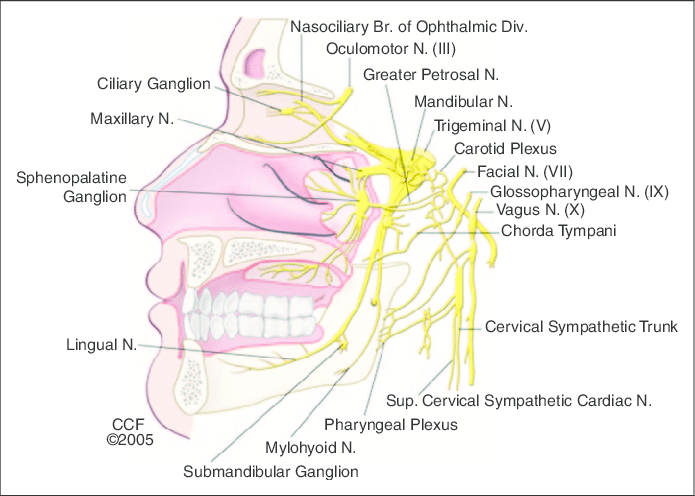Sphenopalatine ganglion Radiofrequency Neurectomy MIPSI
MIPSI or Minimally invasive pain and spine interventions is a broad term which encompasses all the Non-invasive and minimally invasive interventions done by the interventional spine and pain physicians for myriad of conditions right from Musculo-skeletal disorders like back pain, neck pain, knee pain etc.

What is Sphenopalatine ganglion and where is it situated?
Sphenopalatine ganglion, also known as Pterygopalatine ganglion or Nasal ganglion is a Parasympathetic ganglion located in the Pterygopalatine fossa.
It is the largest of the Parasympathetic ganglia and is triangular or heart shaped and located just below the Maxillary nerve as it crosses the fossa.
It is largely innervated by Greater Petrosal nerve and supplies the lacrimal gland, paranasal sinuses, glands of the mucosa of the nasal cavity and the pharynx, the gingiva and the mucous membrane and glands of the hard palate.
What is the procedure of Sphenopalatine ganglion Radiofrequency neurectomy?
Sphenopalatine ganglion Radiofrequency neurectomy is an advanced procedure which involves the precise placement of the Radiofrequency needle in the Pterygopalatine fossa and identification of the ganglion with the help of sensory and motor stimulation and then its targeted ablation using Radiofrequency current.
Access to this ganglion is achieved through the Pterygopalatine fossa which is an inverted pyramidal shaped, fat filled space located on the lateral side of the skull, between the Infratemporal fossa and the Nasopharynx. This opening is identified using a Fluoroscope machine and then a radiofrequency needle is inserted from the mandibular notch of the patient targeting this foramen.
Whole procedure is done under local anaesthesia with some mild sedation.

What are the Indications of Sphenopalatine ganglion neurectomy?
- Trigeminal autonomic cephalgia like Cluster headache, SUNCT, Paroxysmal hemicrania
- Atypical facial pain
- Oral cancer with persistent Oro-facial pain
- Trigeminal neuralgia along with Gasserian ganglion RF ablation
- Post-dural puncture headache
How Sphenopalatine ganglion neurectomy MIPSI helps relief pain?
Sphenopalatine ganglion Radiofrequency neurectomy mainly acts by 2 mechanisms:
Peripheral Wallerian degeneration of the nerve: Due to the application of Radiofrequency currents , the friction between the various tissue molecules generate thermal energy which burns the nerves and brings about what is called as conduction block. So these nerves stop conducting pain signals from the affected site towards the brain where pain stimulus is actually processed and patient feels immediate relief from pain.
Central neuromodulation: Chronic pain has a component of Central Sensitization where in there is amplification of the pain signals in the brain and patients experience pain even in the absence of any movements or painful stimulus. With application of Radiofrequency ablation there is modulation in these central neural circuitries and the central sensitization is abolished.
How early the beneficial effects can be seen?
Patient can start appreciating the effect of the procedure within 3-4 days and maximal effect is achieved over a period of 3-4 weeks.
How many times this procedure has to be repeated?
The effect of this procedure can last from about 6 months to few years, after which this procedure has to be repeated. During this pain free period patient becomes drug free and thus escapes from the side effects of these medications which occur due to prolonged use of the drugs.
Will I require hospitalization for this procedure?
Yes. Patient generally is hospitalized for a period of 24 hours post-procedure for observation.
To see how this procedure is done, click the below link